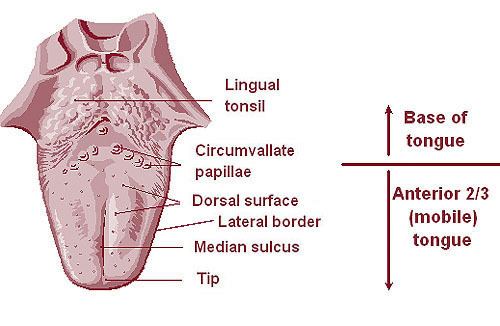Latin tonsilla lingualis | Dorlands/Elsevier t_13/12812439 | |
 | ||
System Immune system (Lymphatic system) | ||
The lingual tonsils are two small mounds of lymphatic tissue located at the back of the base of the tongue, one on either side. They are composed of lymphatic tissue that functions to assist the immune system in the production of antibodies in response to invading pathogenic bacteria or viruses.
Contents
Microanatomy
Lingual tonsils are covered externally by stratified squamous nonkeratinized epithelium. The epithelium invaginates inward to form a single crypt. Beneath the epithelium is a layer of lymphoid nodules containing lymphocytes. These tonsils are surrounded by thin capsule of connective tissue which separates them from adjacent structures. Mucous glands located at the root of tongue are drained through several ducts into the crypt of lingual tonsils. Secretions of these mucous glands keep the crypt clean and free of any debris. Therefore, the lingual tonsils are less prone to infection.
Blood supply
Lingual tonsils are located on posterior aspect of tongue which is supplied through:
Nerve supply
Lingual tonsils are innervated by tonsillar branches of glossopharyngeal nerve.That is located at the back of the tongue.
Function
Like other lymphatic tissues, the function of lingual tonsils is to prevent infections. These tonsils contain B and T lymphocytes which get activated when harmful bacteria and viruses come in contact with tonsils. B lymphocytes kill pathogens by producing antibodies against them, while T lymphocytes directly kill them by engulfing them.
Cancer
Squamous cell carcinoma of lingual tonsils can occur in people above 50 years of age.
Sleep Apnea
Enlarged or hypertrophic lingual tonsils have the potential to cause or exacerbate sleep apnea.
